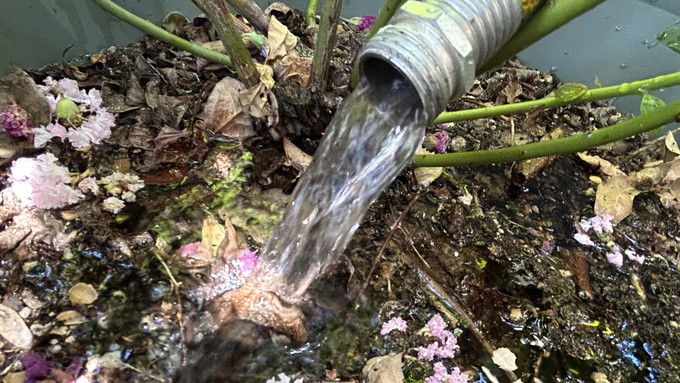
Sacramento could hit 111 degrees this week; remember to water

Plants in containers will need extra care during this hot week -- the soil dries out much quicker than for plants in the ground. Some pots may need to be watered twice a day. Kathy Morrison
This month is starting with a blast of triple-digit temperatures and a combination of official heat-related advisories. This week, an Extreme Heat Risk, Excessive Heat Warning and Red Flag Warning are all in effect as the National Weather Service forecasts temperatures from 105 to 115 in the Sacramento Valley and foothills.
Nights will be sizzling, too. In some places farther inland, overnight LOWS will stay in the 80s. It could still be 90 degrees when folks are watching after-dark fireworks on July Fourth.
Early mornings and evenings may be the only times to venture outside.
“Avoid outdoors in the sun from 10 a.m. to 6 p.m.,” says the weather service. “Stay in a cool place, especially during the heat of the day.”
The weather service keeps tweaking its forecast, turning the expected highs up a notch. As of Monday morning (July 1), the forecast highs for Sacramento are 108 on Tuesday, 111 on Wednesday, 110 on Thursday’s July Fourth holiday, and 109 on Friday and Saturday. Monday’s expected 104 may be the coolest day of the week. (Sacramento’s all-time record for July: 114 degrees.)
“Stay hydrated,” says the weather service.
That goes for your gardens, too. Water deeply and early, preferably before 8 a.m.
July is usually Sacramento’s hottest month of the year. According to the weather service, Sacramento highs in July average 92.6 degrees; lows average 59.2. This week’s temperatures will be significantly higher than both.
How does this week stack up against July 2023? We started that month even hotter; July 1, 2023, hit a record 107 degrees. But due to a return of the Delta Breeze, July Fourth 2023 was only 88 degrees.
Overall, July 2023 was on the warm side; high temperatures averaged 94.3 degrees, almost two degrees above normal. In all, July 2023 totaled eight days in triple digits (peaking at 107 twice), but seven days in the 80s or 70s. That’s also typical of July; it’s not hot EVERY day.
Another aspect was totally normal: Sacramento did not see a drop of rain in July 2023. It’s unlikely we’ll see any this month either.
That means our gardens are totally dependent on irrigation; don’t forget to water! Transplants are quick to dry out; so are seedlings. Lack of consistent moisture can cause blossom end rot on tomatoes, peppers and other summer favorites.
For our gardens, there are some positives about this heat wave. High temperatures kill most fungal diseases. Say goodbye to powdery mildew, rust and blackspot.
Triple-digit temperatures also impact reproduction of some garden pests such as stinkbugs. This extended blast could wipe out an entire generation.
One more plus: Grass tends not to grow when it’s hotter than 100 degrees. Skip mowing – and relax with a cool drink indoors.
Comments
0 comments have been posted.Sacramento Digs Gardening to your inbox.
Sites We Like
Garden Checklist for week of Oct. 27
It's still great weather for gardening. Grab a sweater – and an umbrella, just in case – then get to work:
* October is the best month to plant trees, shrubs and perennials.
* Harvest pumpkins and winter squash.
* Pick apples and persimmons. Remember to pick up fallen fruit, too; it attracts pests.
* Clean up the summer vegetable garden and compost disease-free foliage.
* Dig up corms and tubers of gladioli, dahlias and tuberous begonias after the foliage dies. Clean and store in a cool, dry place.
* Treat azaleas, gardenias and camellias with chelated iron if leaves are yellowing between the veins.
* Now is the time to plant seeds for many flowers directly into the garden, including cornflower, nasturtium, nigella, poppy, portulaca, sweet pea and stock.
* Plant seeds for radishes, bok choy, mustard, spinach and peas.
* Plant garlic and onions.
* Set out cool-weather bedding plants, including calendula, pansy, snapdragon, primrose and viola.
* Reseed and feed the lawn. Work on bare spots.